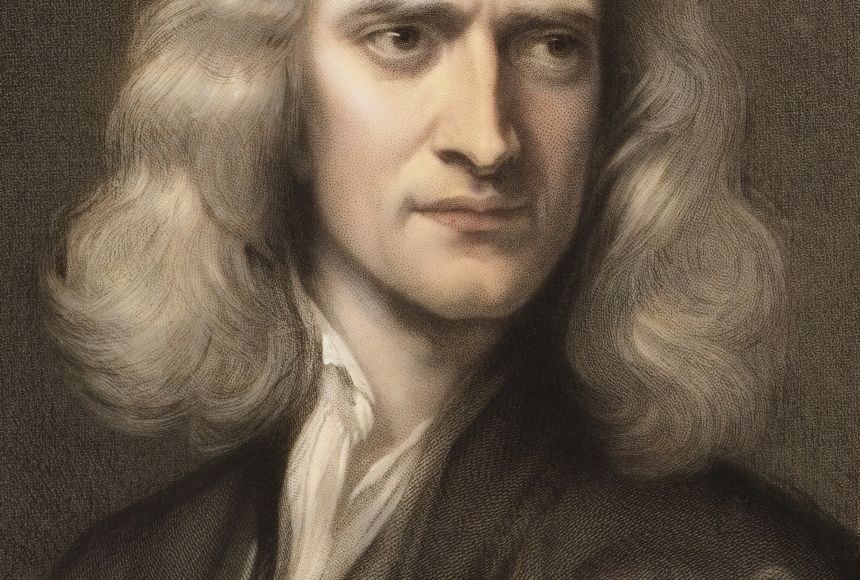Physically, Sir Isaac Newton was not a large man. However, he had a large intellect, as shown by his discoveries on gravity, light, motion, mathematics, and more.
Legend has it that Isaac Newton came up with gravitational theory in 1665, or 1666, after watching an apple fall. He asked why the apple fell straight down, rather than sideways or even upward. "He showed that the force that makes the apple fall and that holds us on the ground is the same as the force that keeps the moon and planets in their orbits," Martin Rees says. He is a former president of Britain's Royal Society, the United Kingdom's national academy of science, which was once headed by Newton himself.
"His theory of gravity wouldn't have got us global positioning satellites," said Jeremy Gray, a mathematical historian at the Open University in Milton Keynes, U.K. "But it was enough to develop space travel."
The Cambridge Years
Newton was born two to three months prematurely on January 4, 1643, in Lincolnshire, England. A practical child, he enjoyed constructing models, including a tiny mill that actually ground flour—powered by a mouse running in a wheel.
Admitted to the University of Cambridge on 1661, Newton at first failed to shine as a student. In 1665, the school temporarily closed because of the bubonic plague, a disease that killed more than 100,000 people in London in that period. As a result, Newton went back home to Lincolnshire for two years.
It was around that time that the apple-falling brainstorm occurred. Newton then returned to Cambridge in 1667, and served as a mathematics professor until 1696.
Newton's Advancements
Understanding gravity was only part of Newton's contribution to mathematics and science. His other major interest was calculus, a subject that examines rates, or the measurement of change. Along with German mathematician Gottfried Leibniz, Newton developed differentiation and integration. These two methods are still used in may areas of science. Differentiation is used to measure any rate of change, like how quickly an animal species reproduces. Integration is often used in geometry to calculate areas and volumes.
Newton also took great interest in optics, the study of light and its behavior. This led him to propose, correctly, that white light is actually the combination of light of all the colors of the rainbow. He used his knowledge to show why telescopes back then couldn't reproduce colors accurately. Newton designed a telescope that used mirrors rather than just glass lenses. This allowed the new machine to focus all the colors on a single point, resulting in a crisper, more accurate image. To this day, reflecting telescopes, including the Hubble Space Telescope, are key tools of astronomy.
Newton's apple insight allowed him to develop the three laws of motion. These laws are still used to describe how forces affect objects, like how rockets fly or baseballs move. A force may be thought of as a push or pull in a specific direction.
First Law of Motion: Inertia
An object at rest will stay at rest, and an object in motion will stay in motion along a straight line unless moved by an outside force.
Second Law of Motion: Acceleration
An object will accelerate if force is applied to it. Acceleration is the rate of change of an object's velocity. The acceleration will happen in the direction of the force. For a fixed force, bigger objects will have a smaller acceleration.
If the mass does not change, force equals mass times acceleration, or F = ma.
Third Law Of Motion: Action and Reaction
For every action, there is an equal and opposite reaction. For example, say Object A hits Object B. This means that A is exerting a force on B in a certain direction. By Newton's third law, A is also receiving a force by B. The two forces are equal and are directed in opposite directions.
The "Principia"
Newton published his findings in 1687, in a book called Philosophiae Naturalis Principia Mathematica. The Latin title is translated as Mathematical Principles of Natural Philosophy, and the book is commonly known as the Principia.
"Newton's Principia made him famous—few people read it, and even fewer understood it," wrote mathematician Robert Wilson of the Open University. "But everyone knew that it was a great work, rather like Einstein's Theory of Relativity over two hundred years later."
The Vain and Vengeful Years
Despite his wealth of discoveries, Newton wasn't well-liked, particularly in old age. At that point, he served as the head of Britain's Royal Mint, which printed money and created coins. He also served in Parliament, a branch of the British government, and wrote on religion, among other things. As a personality, Newton was solitary when young, and vain and vengeful in his later years, Rees says. He "sabotaged his rivals," Rees adds.
Sir David Wallace is director of the Isaac Newton Institute for Mathematical Sciences in Cambridge, England. He said Newton "was a complex character, who also pursued alchemy"—the search for a method to turn common metals into gold. As Master of the Mint, Newton showed no mercy toward counterfeit coin-makers sentenced to death, Wallace says.
In 1727, at 84, Sir Isaac Newton died in his sleep. He was buried with much ceremony in Westminster Abbey in London, England.

